The Singing Revolution Library
Full Access
Throughout the course of creating The Singing Revolution over 100 hours of original footage was filmed, and another 20 hours of archival footage and research materials acquired from a wide variety of sources.
The very first rough cut of the film was more than four hours long! It took us over a year to cut the film down to the 97-minute version that is now the film known as The Singing Revolution.
But there were many, many stories and nuances that could not be included in a film 1½ hours in length. We have now assembled over 4 ½ hours of additional interview sound bites into 23 different videos arranged by subject matter. We identified seven historical newsreels related to that content. We also selected 30 relevant documents that correlate to the commentaries. And we have put together 15 maps of Europe from 180 AD until 1997 that make clear Estonia’s evolving political history.
In our library we also provide a full cut of the final film with filmmaker commentary on decisions made while crafting the story, shooting challenges and what happened behind the scenes. We explain the challenges and ultimate decisions made in making The Singing Revolution. There also is a brief interview with the Tustys made just after the film was completed but before it was released.
We have tried to create a library that is user-friendly for people to find the material that interests them without slugging through material not of interest. Clicking on any headline below will reveal a short description of the content and suggestions for other relevant material to review.
The TSR Library is intended for those academics, students, film fans, Estofiles, nonviolent activists, history buffs, choral singers and others who wish to learn more about the extraordinary events that led to the successful nonviolent revolution known as the Singing Revolution.
Click on each title below to learn more.
Special Thanks to the Estonian American National Council for their support of the TSR Digital Library.
Want Full Access?
Click below to purchase access to the full TSR Digital Library – $99.95/ Year.
For Personal Use Only
Already Purchased Access?
Click the button below to use your email address or Screening ID to access to the TSR Library.
SECTION 1: 1939-1956: THE SOVIET AND NAZI OCCUPATIONS
Videos
closed
Comments on the Atlantic Charter/Yalta/Hungarian Uprising (7:31)

Learn the chilling details regarding the post World War II Realpolitik decisions of the Allies that left the Baltic Countries, and later Hungary, victims of a brutal Soviet occupation.
Video
- Comments on the Atlantic Charter/Yalta/Hungarian Uprising
Associated Newsreels:
- 1956 Hungarian Revolution
- Yalta newsreel
Associated Documents
- 1939 transcripts of Soviet-Estonian “negotiations” with Stalin
Estonians Fleeing Stalin – Waiting to Return (12:44)
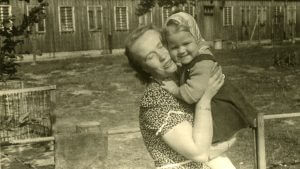
Hear the stories of two people whose parents fled Stalin with them as small children, both of whom ended up in the United States. How did Estonians who stayed behind in Estonia feel about the many refugees?
Video
- Estonians Fleeing Stalin – Waiting to Return (12:44)
Associated Documents
Deportation Stories – Mari-Ann Kelam (1:29) [Free Content]
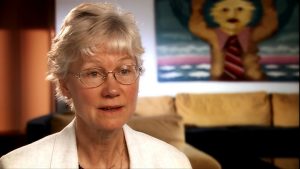
Hear an overview regarding the Soviet deportations of an estimated 8%-14% of the Baltic Countries.
Video
- Deportation Stories – Mari-Ann Kelam (1:29)
Deportation Stories – Enn Sarv (6:10)
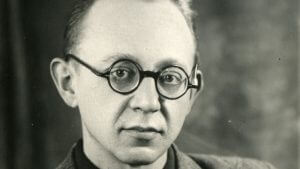
Enn Sarv resisted both the German occupation and the Soviet occupation. As a result, he was imprisoned first in a German Concentration Camp. Then, after the war, he came home and subsequently was arrested by the in Soviets and sent to the Gulag. His fiancée waited for him all that time.
Video
- Deportation Stories – Enn Sarv (6:10)
Associated Documents
- 1986 Letter to the West from a Gulag Prisoner
Deportation Stories – Heiki Ahonen (3:15)

Heiki Ahonen’s parents met while both were imprisoned in Soviet Labor Camps in the 1940s. He shares their story. Due to this history of his parents, Heiki was a marked man to the Soviets and was arrested himself in 1983 due to his anti-Soviet activities.
Video
- Deportation Stories – Heiki Ahonen (3:15)
Associated Documents
- 1986 Letter to the West from a Gulag Prisoner
Deportation Stories – Heino Noor (8:15)
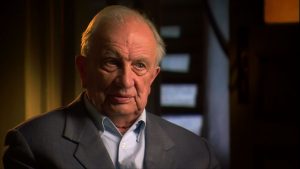
Heino Noor was imprisoned simply because his parents were put into Labor Camps because they had been in the Estonian Army. Heino’s mother was executed by gunshot while at the camp. In 1991, after Estonia regained its independence, Heino learned the name and address of his mother’s executioner. The man was living in Tallinn, and Heino knew where. He agonized over what to do.
Video
- Deportation Stories – Heino Noor (8:15)
Associated Documents
- 1986 Letter to the West from a Gulag Prisoner
Deportation Stories – Tiia-Ester Loitme (9:52)
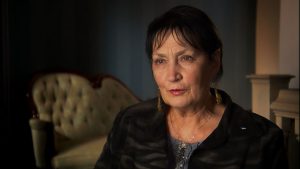
Tiia-Ester Loitme is featured inThe Singing Revolution, and her story of being sent to the Gulag at age 14 is covered in the film. Learn more about how she survived and became a noted Estonian choir conductor. Since 1989, she has been chief conductor of the Grammy Award-winning choir Ellerhein.
Video
- Deportation Stories – Tiia-Ester Loitme (9:52)
Associated Documents
- 1986 Letter to the West from a Gulag Prisoner
Deportation Stories – Matti Päts (6:19)

Matti Päts is the grandson of Estonian President Konstantin Päts. When the Soviets occupied Estonia in 1939, President Päts, his children and grandchildren became the second family to be deported to the Gulag (the first being Estonian Army General Laidoner’s family). At 8 years old, Matti was sent to a Soviet orphanage along with his younger brother, who died of starvation. Hear his family’s story.
Video
- Deportation Stories – Matti Päts (6:19)
Associated Documents
Forest Brother Alfred Käärmann (50:41)
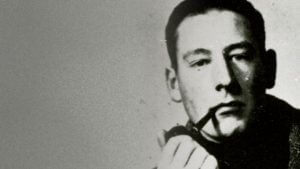
Alfred Käärmann fought the Soviets as a Forest Brother from 1944 – 1952. He was captured and sent to Soviet prison. He was released in 1967. But he was constantly harassed by the Soviets until Estonian independence in 1991. Hear his full, powerful story.
Sample Video
- Sample of Forest Brother Alfred Käärmann (1:42)
- View the full interview by purchasing The Singing Revolution Digital Library Annual Subscription
Associated Documents
- 1941 Executions in Kuressaare Castle
- 1941 Request for Names of Those Executed in 1940-41
- 1941 The Fate of Estonian Army Staff Officers
- 1942 The Fate of Professor Ants Piip
1939 German Newsreel of Soviet/Nazi Joint Victory Parade in Poland (4:14)
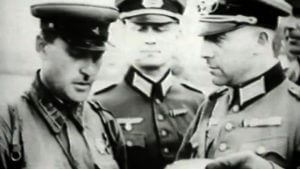
World War II was started with the Nazis invading Poland from the West and the Soviets from the East. The Soviet and Nazi armies met in the middle of Poland and celebrated with a joint victory parade. The Soviet general was Jewish.
Video
- 1939 German Newsreel of Soviet/Nazi Joint Victory Parade in Poland (4:14)
1945 Yalta Newsreel (7:17) [Free Content]
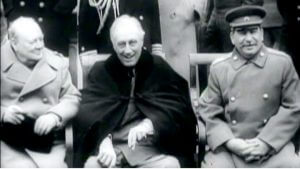
This arguably was the very meeting where the Baltic countries were given away by Roosevelt and Churchill.
Video
- 1945 Yalta Newsreel (7:17)
Soviet Propaganda Film (1:40)
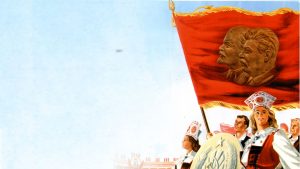
This film is so ludicrous, it’s funny. But not so for those living under Stalinist rule.
Video
- Soviet Propaganda Film (1:40)
1956 Hungarian Uprising Newsreels
In 1956, Hungarian partisans overthrew their Soviet occupiers. They had been led to believe that the Western nations would support them. No one came to help them, and the Soviet army came back to crush the resistance. These 4 contemporary newsreels reveal how the story unfolded.
Videos
- Part 1: October 28, 1956 (1:05)
- Part 2: November 5, 1956 (0:59)
- Part 3: November 8, 1956 (0:42)
- Summary: 1956 “Year in Review” (0:45)
Documents
closed
1920 Treaty of Tartu
The Treaty of Tartu is the agreement between the new country of Estonia and the Soviet Union. Part of the agreement reads, “Russia unreservedly recognizes the independence and sovereignty of the State of Estonia, and renounces voluntarily and forever all sovereign rights possessed by Russia over the Estonian people and territory.” This clause was blatantly violated by Stalin some 20 years later. After an English translation of the Treaty is a facsimile of the original last page with signatures.
Associated Documents
- 1920 Treaty of Tartu
Related Video
- Estonian Independence Day (1:40)
1939 The Molotov-Ribbentrop Pact
The agreement between Stalin and Hitler that started World War II, including the secret protocols that divided parts of Europe up into Soviet and Nazi spheres. An English translation of the Pact is followed by facsimiles of the Russian and German language agreements.
Associated Documents
- 1939 The Molotov-Ribbentrop Pact
Related Video
- The Baltic Bloc – MRP Acknowledgment in Moscow (8:58)
1939 Transcripts of Soviet-Estonian “Negotiations” with Stalin
This chilling 33-page transcript reveals the difficult negotiations Estonian representatives had with an overwhelmingly more powerful Soviet Union, led by Stalin. What was the best the Estonians could negotiate? Stalin’s assessment is thus, “I can tell you that the Estonian government acted well and wisely in the interests of the Estonian people by concluding the agreement with the Soviet Union. It could have happened to you what happened to Poland. Poland was a great country. Yet, where is Poland now? Where is Moscicki, Rydz-Smigly, Beck? Yes, I am telling you frankly—you acted well and
in the interests of your people.” In other words, “Sign or we will crush you.”
Document
- 1939 Transcripts of Soviet-Estonian “Negotiations” with Stalin
Related Video
- The Baltic Bloc – MRP Acknowledgment in Moscow (8:58)
- Comments on the Atlantic Charter/Yalta/Hungarian Uprising (7:31)
1941 Executions in Kuressaare Castle [Free Content]
This gruesome document shares the utter brutality of the Soviet occupation.
Alfred Käärmann’s full 50 minute interview can be heard with purchase of the TSR Digital Library access pass.
Document
- Download PDF 1941 Executions in Kuressaare Castle
Related Video
- Sample of Forest Brother Alfred Käärmann (1:42)
1940-55 Personal Memories: Fate of Estonian President Päts’ Family
Helgi-Alice Päts was daughter-in-law of Konstantin Päts, President of the Republic of Estonia when the Red Army came in and occupied the nation. This is her chronicle of the ordeal that Päts and his family endured.
Document
- 1940-55 Personal Memories: Fate of Estonian President Päts’ Family
Related Video
- Deportation Stories – Matti Päts
1941 Request for Names of Those Executed in 1940-41
In order to establish who ruled Estonia, Stalin established “Destroyer Battalians”, whose only purpose was to kill entire villages and burn them to the ground. This 1988 article calls for identifying all those murdered by the Battallians.
Document
Related Video
- Forest Brother Alfred Käärmann (50:41)
1941 The Fate of Estonian Army Staff Officers
In 1941, the Soviet Army sent 246 Estonian military officers to Labor Camps. Not much was known about what exactly happened to them. This document shares the 1950 account given by one of the imprisoned officers to another prisoner.
Document
- 1941 The Fate of Estonian Army Staff Officers
Related Video
- Forest Brother Alfred Käärmann (50:41)
1942 The Fate of Professor Ants Piip
Professor Piip was an early Estonian Prime Minister after independence. The Soviets arrested him in 1941 and he died in a Siberian Labor Camp the next year.
Document
- 1942 The Fate of Professor Ants Piip
Related Video
- Forest Brother Alfred Käärmann (50:41)
White paper on the Estonian Occupation [Free Content]
In 1992, the Riigikogu of the Republic of Estonia (the Estonian Parliament) established the Estonian State Commission on Examination of the Policies of Repression (ESCEPR) and set a goal of publishing a scientific investigation into all the losses and damages suffered by the Estonian nation during the Soviet and Nazi occupation regimes. After 12 years of research, they completed this 176-page report.
Document
- Download PDF White paper on the Estonian Occupation
1945 Crossing the Atlantic Ocean in a 37-foot Boat
This is a diary of Estonian refugee crossing the Atlantic Ocean in a 37-foot boat.
Document
- 1945 Crossing the Atlantic Ocean in a 37-foot Boat
Related Video
- Estonians Fleeing Stalin – Waiting to Return (12:44)
SECTION 2: 1957-1986: THE STAGNATION YEARS
Videos
closed
The Role of Finnish TV, Voice of America & Radio Free Europe (6:20)
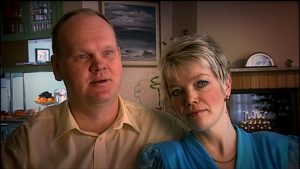
Truth was hard to come by in the Soviet Union. The government controlled all sources of information, and used those pipelines to endorse itself. Due to their geographical location, Estonians in the north could access Finnish TV for a window on the West. Voice of America and Radio Free Europe also provided important information. The Soviets spent much time and money trying to scramble those signals.
Video
- The Role of Finnish TV, Voice of America & Radio Free Europe (6:20)
Comments from Trivimi Velliiste: The Acorn Book Club (8:52)

Learning how to camouflage plans for independence from the Soviet authorities became a masterful art form in Estonia. The Acorn Book Club is a great example. In the 1970s the Soviets announced plans to fight illiteracy. Freedom-minded Estonians formed a “book club” under the guise of fighting illiteracy (which didn’t really exist in Estonia). In reality, members were reading books, some forbidden, to prepare themselves to create a free Estonia someday.
Video
- Comments from Trivimi Velliiste: The Acorn Book Club (8:52)
Related Document
- 1989 Interview with Trivimi Velliste
Estonian Dissidents (6:48)

Learn how Soviet dissidents functioned, what motivated them and what they were thinking.
Video
- Estonian Dissidents (6:48)
Related Document
- 1986 Letter to the West from a Gulag Prisoner
Soviet Education and Youth - Sample Video(0:58) [Free Content]
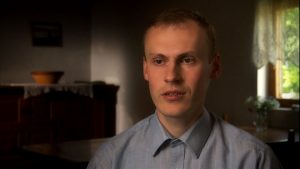
Hear about the conflicting lessons of history Estonian children learned at home compared to what they heard at school. Hear the full story of a teenage rebel being arrested and interrogated by the Soviet Secret Police (the KGB) for simply sporting a Mohawk haircut dyed bright red. This is a sample clip from the full segment.
The full video can be viewed with purchase of the TSR Digital Library access pass.
Video
- Sample from the Soviet Education & Youth video (0:58)
Estonian Independence Day (1:57)

Estonians declared their independence on February 24, 1918. Fifty years of Soviet occupation starting in 1940 never changed the importance and legitimacy of that first “Independence Day”.
Video
- Estonian Independence Day (1:57)
Related Documents
- 1920 Treaty of Tartu
- 1973 Congressional Resolution of Non-Recognition
Soviet Education and Youth - Full Video (13:12)

Hear about the conflicting lessons of history Estonian children learned at home compared to what they heard at school. Hear the full story of a teenage rebel being arrested and interrogated by the Soviet Secret Police (the KGB) for simply sporting a Mohawk haircut dyed bright red.
Video
- Soviet Education and Youth (13:12)
Documents
closed
1973 Congressional Resolution of Non-Recognition
The United States, and other Western nations, never recognized the legality of the Soviet occupation of Estonia. This Congressional Resolution is one of many reaffirming that position.
Document
- 1973 Congressional Resolution of Non-Recognition
Related Video
- Estonian Independence Day (1:40)
1986 Letter to the West from a Gulag Prisoner
A letter smuggled out of a Soviet Labor Camp written by a political prisoner.
Document
- 1986 Letter to the West from a Gulag Prisoner
Related Video
- Deportation Stories – Enn Sarv (6:10)
- Deportation Stories – Heiki Ahonen (3:15)
- Deportation Stories – Heino Noor (8:15)
- Deportation Stories – Tiia-Ester Loitme (9:52)
SECTION 3: 1987-1991: THE SINGING REVOLUTION
Videos
closed
Comments on the Popular Front (9:02)
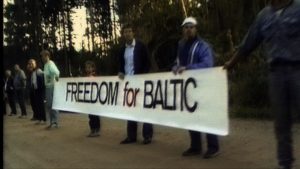
The Popular Front sought change, but not full independence. They felt they were more realistic than those seeking outright independence, and therefore would be more successful. They were hoping for greater freedom within the confines of being part of the Soviet Union. Revolutions, even successful ones, are not always united. Hear about some of the tensions within the various Estonian movements.
Video
- Comments on the Popular Front (9:02)
Details on the 1987 Hirve Park Demonstration (10:53)
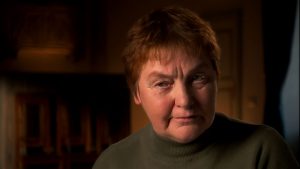
Gorbachev introduced the concept of “Glasnost”, or open discussion of political and social issues. He never dreamed how far Estonians would take that concept. The 1987 Hirve Park demonstration was a bold challenge to the legality of the Soviet occupation. Demands were made to put Stalin’s henchmen in jail.
Video
- Details on the 1987 Hirve Park Demonstration (10:53)
Related Documents
- 1987 Demonstration at Hirve Park—All Speeches
- 1987 Hirve Park Eye Witness Account
- 1987 Interview with Lagle Parek (her interview was days before the demonstration)
- 1987 Political Prisoners Languish under Gorbachev
Tunne Kelam on the Citizens Registration (9:56)

In 1988, over 800,000 Estonians (virtually every adult in the country) signed a petition denying the legality of the Soviet occupation and declaring themselves citizens of the 1939 Republic of Estonia. This led to an election of the “Congress of Estonia” in 1990…done while the Soviets were still in power. Hear Tunne Kelam explain the legal concept, share what was behind those events and their astonishment at the turnout.
Video
- Tunne Kelam on the Citizens Registration (9:56)
Related Documents
- 1989 Republic of Estonia Citizens’ Registration
- 1989 Citizens’ Committee Response to Criticism
- 1989 Independence Day Speech by Tunne Kelam
- 1990 Explanation: Importance of Congress of Estonia Elections
Comments on Gorbachev (6:54) [Free Content]
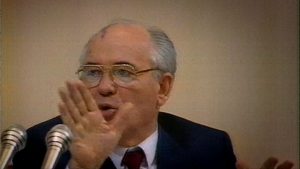
Gorbachev is often seen in the West as a freedom-leaning Soviet leader. That is not the view of those who lived under his rule.
Video
- Comments on Gorbachev (6:54)
Related Documents
- Download PDF 1987 Political Prisoners Languish under Gorbachev
- Download PDF 1987 Open Letter to Gorbachev
- Download PDF 1988 Firsthand Account of the Sovereignty Vote
Role of Culture Under Soviet Occupation (7:00)
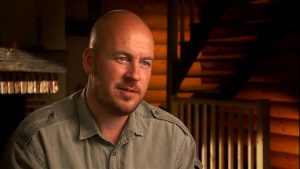
Learn how Shakespeare’s play Hamlet was turned into a message of hope for a free Estonia…right under the eyes of Soviet authorities. When government controls schools, television, radio and the print press, double entendre in the arts becomes a principal pipeline of truth.
Video
- Role of Culture Under Soviet Occupation (7:00)
Related Document
- 1988 Speeches at the Estonian Cultural Union Meeting
Comments on the Role of Vaino Valjas (31:16)
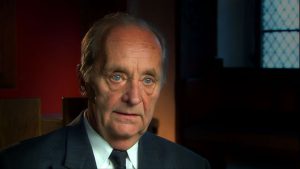
From 1978 until 1988, Estonian’s Communist Party was led by hard-liner Karl Vaino. In 1988, in order to calm down the Estonian hunger for independence, Gorbachev replaced him with native Estonian Vaino Valjas, a childhood friend of Gorbachev’s with a much softer approach than Karl Vaino. Valjas was a dedicated Communist who was not seeking Estonian independence, yet he tolerated, and perhaps even encouraged, a great deal of Estonian independence aspirations. So was he a good guy or a bad guy? This clip starts with some Estonian perspectives on Valjas, but it predominantly consists of
Vaino Valjas’s own words about what happened. You can judge for yourself. It is rare to have access to such “inside baseball”.
Video
- Comments on the Role of Vaino Valjas (31:16)
Related Document
- 1988 Firsthand Account of the Sovereignty Vote
The Baltic Bloc – MRP Acknowledgment in Moscow (8:56)

The Molotov-Ribbentrop Pact was an agreement between Nazi Germany and Stalin’s Soviet Union that contained secret protocols turning the Baltic countries (Estonia, Latvia, Lithuania) over to Stalin. For 50 years, the Soviet Union denied that these protocols existed. Hear the story of how they were finally exposed.
Video
- The Baltic Bloc – MRP Acknowledgment in Moscow (8:56)
Related Document
- 1939 The Molotov-Ribbentrop Pact
Comments on the August 1991 Coup - Full Video (19:45)
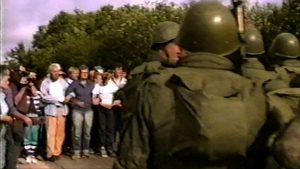
The Moscow Coup happened in 1991. Tanks rolled into Estonia. Hard-line Soviet occupation was back and no one knew how it would end. We now know the Coup would collapse and Estonia would become a free nation. But how did things seem at that time?
Sample Video
- Sample from the Comments on the August 1991 Coup video (1:17)
Documents
closed
1987 Political Prisoners Languish under Gorbachev [Free Content]
An open letter to Gorbachev seeking freedom for political prisoners.
Document
- Download PDF 1987 Political Prisoners Languish under Gorbachev
Related Video
- Comments on Gorbachev (6:54)
1987 Open Letter to Gorbachev [Free Content]
A 1987 letter challenging Gorbachev to let Estonia secede from the Soviet Union.
Document
- Download PDF 1987 Open Letter to Gorbachev
Related Video
- Comments on Gorbachev (6:54)
1987 Demonstration at Hirve Park—All Speeches
9 pages of exactly what was said (translated into English.)
Document
- 1987 Demonstration at Hirve Park—All Speeches
Related Video
- Details on the 1987 Hirve Park Demonstration (10:53)
Related Document
- 1987 Hirve Park Eye Witness Account
1987 Hirve Park Eye Witness Account
A narrative of the Hirve Park demonstration as told by some people in attendance.
Document
- 1987 Hirve Park Eye Witness Account
Related Video
- Details on the 1987 Hirve Park Demonstration (10:53)
Related Document
- 1987 Demonstration at Hirve Park—All Speeches
1987 Interview with Lagle Parek
This interview takes place days before the Hirve Park demonstration. Lagle Parek talks about that upcoming event.
Document
- 1987 Interview with Lagle Parek
Related Video
- Details on the 1987 Hirve Park Demonstration (10:53)
1988 Creation of the Estonian National Independence Party
The document that created the first independent political party in the Soviet Union.
Document
- 1988 Creation of the Estonian National Independence Party
Related Video
- Tunne Kelam on the Citizens Registration (9:56)
1988 Firsthand Account of the Sovereignty Vote [Free Content]
Arnold Rüütel was Supreme Council Chairman when the Council voted in 1988 to make Estonian laws supreme over Soviet laws written in Moscow. This infuriated Gorbachev.
Document
- Download PDF 1988 Firsthand Account of the Sovereignty Vote
Related Video
- Comments on Gorbachev (6:54)
- Purchase to Watch Comments on the Role of Vaino Valjas (31:16)
1988 Speeches at the Estonian Cultural Union Meeting
When government controls all press and education, truth often emerges through double entendre in the arts. In that sense, artists became Estonian cultural leaders, even political leaders, during the Soviet Occupation. In 1988, speeches at the Cultural Union meeting became ever more open about the desire for a free Estonia.
Document
- Role of Culture Under Soviet Occupation (7:00)
1988 Memorandum to the United Nations
An open letter to the UN asking it to recognize Estonia, Latvia and Lithuania as free nations and to exert pressure on the Soviet Union to leave the Baltic countries.
Document
- 1988 Memorandum to the United Nations
1989 Republic of Estonia Citizens’ Registration
This is the technical document that gave structure to the registration of Estonian citizens.
Document
- 1989 Republic of Estonia Citizens’ Registration
Related Video
- Tunne Kelam on the Citizens Registration (9:56)
Related Documents
- 1989 Citizens’ Committee Response to Criticism
- 1990 Explanation: Importance of Congress of Estonia Elections
1989 Citizens’ Committee Response to Criticism
The Estonian Supreme Soviet condemned the registration of Estonian citizens and the establishment of Citizens Committees. This document refutes accusations of “adventurism, separatism and inflammation of inter-ethic tensions”.
Document
- 1989 Citizens’ Committee Response to Criticism
Related Video
- Tunne Kelam on the Citizens Registration (9:56)
Related Documents
- 1989 Republic of Estonia Citizens’ Registration
- 1990 Explanation: Importance of Congress of Estonia Elections
1989 Independence Day Speech by Tunne Kelam
In 1989 Tunne Kelam called for outright independence and the expulsion of the Soviet Union from Estonia.
Document
- 1989 Independence Day Speech by Tunne Kelam
Related Video
- Tunne Kelam on the Citizens Registration (9:56)
1989 Interview with Trivimi Velliste
In this interview, Trivimi Velliste argues that freeing the Baltic countries would strengthen, not weaken, the Soviet Union.
Document
- 1989 Interview with Trivimi Velliste
Related Video
- Comments from Trivimi Velliiste: The Acorn Book Club (8:52)
1990 Explanation: Importance of Congress of Estonia Elections
Document
- 1990 Explanation: Importance of Congress of Estonia Elections
Related Video
- Tunne Kelam on the Citizens Registration (9:56)
Related Documents
- 1989 Republic of Estonia Citizens’ Registration
- 1989 Citizens’ Committee Response to Criticism
1986-1988 Chronology of Selected Estonian Events
A detailed chronology of the Singing Revolution 1986-1988 events.
Document
- 1986-1988 Chronology of Selected Estonian Events
1989 Chronology of Selected Estonian Events
A detailed chronology of the Singing Revolution 1989 events.
Document
- 1989 Chronology of Selected Estonian Events
SECTION 4: SONG FESTIVAL/LAULUPIDU
Videos
closed
The Importance of the Song Festival/Laulupidu (13:37)
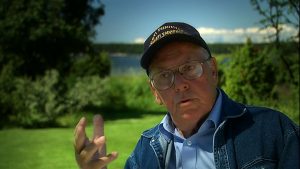
The Estonian Song Festival Laulupidu is a high-level artistic event. But it also has been a critical tool for unifying the country…especially during foreign occupation. Hear about the meaning of Laulupidu to Estonians.
Video
- The Importance of the Song Festival/Laulupidu (13:37)
Song Festival Performance: Ilus maa / Beautiful Land
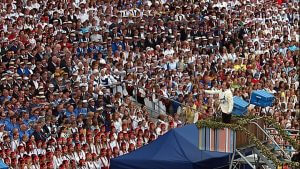
Video
- Song Festival Performance: Ilus maa / Beautiful Land (7:29)
Song Festival Performance: Boys Choirs performing Kikilips / The Bow-Tie Song
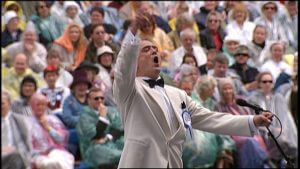
Video
- Song Festival Performance: Boys Choirs performing Kikilips / The Bow-Tie Song (2:58)
Additional Purchase Option: To Breathe as One (full length documentary on the song festival)

More than a song festival, “Laulupidu” is an Estonian miracle that at least twice in history gave freedom to that country. “To Breathe As One” explores the beauty and meaning of the choral festival through the eyes of the young members of the California-based Piedmont East Bay Children’s Choir, one of the few American choirs invited to participate. Learning difficult songs — all in Estonian — the youngsters prepare for months and then set off to join the many thousands from around the world who gather every five years in Tallinn.
Forming cross-cultural friendships that span the oceans, there they discover the unique role that music has played for Estonians for over 150 years, as an integral force in maintaining strength and identity for a people who have faced cultural genocide — more than once.
From the filmmakers of the acclaimed “The Singing Revolution“, the film reveals that for Estonians singing is not just a means of cultural expression but a defining part of their national identity.
Video
- To Breathe As One Official Trailer (2:20)
- Buy Movie To Breathe As One Feature Film
Documents & Music
closed
Mu isamaa on minu arm lyrics in Estonian and English
Document
Mu isamaa on minu arm (Land of my Fathers, Land that I Love) was arguably the most important Estonian song during the Soviet occupation. Its lyrics come from a poem written during the “Great Awakening” by national poet Lydia Koidula. The poem was set to music for the first song festival (Laulupidu) in 1869. Gustav Ernesaks composed new music for the poem for the 1947 Laulupidu…the first song festival held while under Soviet
occupation. Immediately after the 1947 song festival Land of My Fathers, Land that I Love was banned, but Estonians kept the meaning of the song in
their homes and hearts for decades. At the 1960 festival, although still banned, the Estonian choirs spontaneously sang the song at the end of the festival, showing the Soviet authorities that the Estonian spirit was still alive and strong. Even today, Mu isamaa on minu arm is sung at every song festival.
- Mu isamaa on minu arm lyrics.
Song
History of Laulupidu [Free Content]
The Estonian national song festival called Laulupidu has been held 26 times since its inauguration in 1869 through 2014.
Document
- Download PDF History of Laulupidu.
Related Video
- The Importance of the Song Festival/Laulupidu (13:37)
SECTION 5: FILMMAKER COMMENTARY AND INTERVIEW
closed
Interview with filmmakers James and Maureen Tusty (7:37) [Free Content]

Video
A brief interview with the filmmakers created shortly after the release of the film.
- Interview with filmmakers James and Maureen Tusty (7:37)
Filmmaker Commentary (97:40)
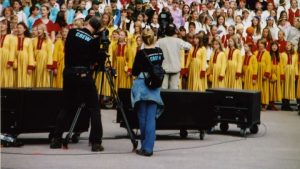
Video
Filmmakers James Tusty and Maureen Castle Tusty talk over the entire film explaining why certain decisions were made. Gain an understanding of the thinking and difficult choices that went into the creation of The Singing Revolution.
- Filmmaker Commentary (97:40)
SECTION 6: ADDITIONAL RESOURCES
closed
European Maps Gallery from 180AD-1997AD
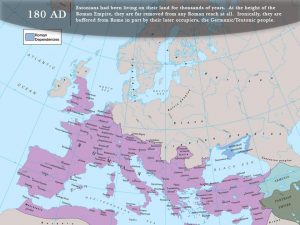
View 15 historical maps of Europe from 180AD to 1997.
Lesson Plan Overview Booklet
25 lesson plans were developed for a variety of subject areas using the additional source materials provided in the TSR Digital Library. Most lesson plans have been designed to fit within a 50-minute class period by using only clips from the film. The variety of lesson options including lessons on nonviolent revolution, the power of music, the influence of geography on a country’s history, and much more. These plans were designed for middle and high school students, but can be adapted for other audiences as well. This booklet provides an overview of the plans. For the full lesson plans,
including forms, PowerPoints and more, one has to subscribe to the Educational version of the TSR Library.
Document
- Download PDF Lesson Plan Overview Booklet